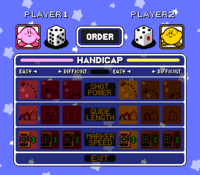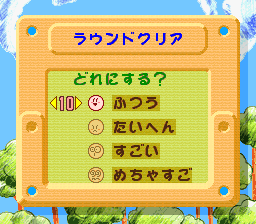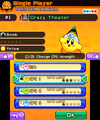
|
It has been requested that image(s) be uploaded and added to this article. Remove this notice once the image(s) have been uploaded and applied.
|
Difficulty is a term that typically refers to adjustable levels of challenge in video games. Difficulty usually comes in terms of defined parameters (such as "Easy", "Normal", "Hard", etc.), as a number rating, or as a gradual meter that can be moved up and down. Basic elements of gameplay typically affected by difficulty include the durability and/or number of enemies, the amount of damage enemies can do, the speed and behavior of enemy attacks and/or stage hazards, and the durability of the playable character(s). Difficulty can also be applied indirectly, by imposing stricter or more lenient requirements on players, such as time limits or score thresholds, or could involve setting entirely new restrictions. Another indirect means of enforcing difficulty involves encouraging players to aim for 100% completion of the game, which usually involves performing optional tasks that are often more difficult than the required sections of gameplay. Players also frequently opt to apply self-imposed restrictions on their gameplay which - while not strictly enforced by the games - can significantly increase the difficulty nonetheless, with popular examples being 'no-damage runs' or speedruns.
In the Kirby series, difficulty is handled in a variety of different ways. While the series in general is catered toward ease of play, there are often many options, Sub-Games or other modes and restrictions that allow for much more difficult gameplay. The most common example of this is the inclusion of Extra Modes and Boss Endurances which are unlocked after the Story Mode is completed. Many Sub-Games also come with rigid difficulty options which the player can select before playing, and often need to be unlocked. Whenever a Computer Player is involved, the player can often opt to change its difficulty level, which will influence its speed and decision-making.
Difficulty by game
The following goes over how notable games in the Kirby series handle difficulty selections in their main game modes. For examples of how difficulty is handled in Sub-Games, check each individual Sub-game article.
Kirby's Dream Land
- Main article: Extra Mode
When the main game of Kirby's Dream Land is completed, the player is presented with a special code consisting of a combination of button inputs (↑, A, and Select) which activates a different version of the game on the title screen called 'Extra Game'. This version of the game plays much like the original, but replaces a lot of enemies with more aggressive versions and changes enemy behavior in general to be more unforgiving. Bosses and Mid-Bosses in particular have revised attack patterns which are generally tougher to avoid.
Additionally, there is a hidden configuration mode that allows the player to specify how much health Kirby has, in addition to how many extra lives he can have at maximum. This makes it possible to specify a game where the player can get a Game Over from a single hit.
Kirby's Adventure / Kirby: Nightmare in Dream Land
Much like its predecessor, Kirby's Adventure features an Extra Game, which can only be unlocked by attaining 100% completion in the main game. However, the only difference is that Kirby only has three bars of health as opposed to the full six, and the player's progress cannot be saved.
In Kirby: Nightmare in Dream Land, it is possible to save during the Extra Game. However, the addition of Meta Knightmare adds a timed run-through of the game with similar difficulty and the inability to save.
Kirby's Dream Course

In the 2P Game menu for
Kirby's Dream Course, players can set handicaps for themselves to make certain guides for making shots more or less difficult to use.
In the single-player courses in Kirby's Dream Course, difficulty can depend on which medal the player is aiming for, as earning a higher medal requires fewer overall shots in each course.
In the 2P Game, players can choose handicap settings for themselves to adjust how difficult it is to accurately make shots.
Kirby's Avalanche
In the Competition Mode of Kirby's Avalanche, there are three difficulty levels, listed as "Easy", "Normal", and "Hard". Each difficulty selection determines which opponents Kirby will face and how skilled they will be, and only by playing Normal or Hard mode can the final boss (King Dedede) be faced and the game completed.
In 1P vs. 2P and Practice Mode, a handicap can be set for each player, which increases the speed at which Puyos fall. 1P vs. 2P features Mild, Medium, Spicy, Hot, and Cajun as the difficulty options. In Practice Mode, there is only Mild, Spicy, and Cajun; selecting Spicy difficulty will add 40,000 points to the player's total score, and selecting Cajun will add 90,000 points.
Kirby's Dream Land 2 / Kirby's Dream Land 3 / Kirby 64: The Crystal Shards
- Main article: False Ending
All three of these games take a slightly different approach to difficulty from the rest of the series. While not featuring extra games, they each have a special requirement which must be met, or the adventure will end prematurely with a False Ending. To avoid this, Kirby must locate all of the special collectable items in the regular stages, which are usually either well-hidden or require completing a specific task to obtain before defeating the 'last' boss. This will allow Kirby to proceed to the real final level and face the true final boss to get the good ending.
Kirby's Block Ball
Each regular stage has a score threshold called the 'Borderline score'. The player is challenged to exceed this score on each stage in order to access the final world and complete the game.
Kirby's Star Stacker

The various difficulties levels, as they appear in the SNES version of Kirby's Star Stacker.
In Kirby's Star Stacker for the Game Boy, there are five different levels of difficulty, which affect the starting gameplay speed and the initial block formation. (In the Round Clear mode, the initial block formation is fixed for each round instead). These are, in ascending order, Normal, Hard, Very Hard, Super Hard, and Insane. Initially, only the first four levels of difficulty are available and Insane needs to be unlocked individually in each mode. The Japanese difficulties have slightly different names: やさしい (Easy), ふつう (Normal), たいへん (Hard), すごい! (Very Hard, or literally "Cool!"), and めちゃすご! (Insane, or literally "Super Cool!")
In the SNES version, these are simplified to only four levels of difficulty: ふつう (Normal), たいへん (Hard), すごい (Very Hard), and めちゃすご (Insane). The main story mode initially has one level of difficulty, but upon defeating Gryll, "Pro Mode" opens up, which makes the opponents more difficult.
Kirby Super Star / Kirby Super Star Ultra
Each game on the main corkboard menu is given a difficulty rating which ranges from one star to seven. While there is little variable difficulty in the games themselves, this distinction does afford the player an understanding of which games are considered more difficult than others.
Kirby Tilt 'n' Tumble
The extra game present in this title allows the player to play through the stages again on a tighter time limit and with faster enemies and hazards to contend with.
Kirby Air Ride
While there are no difficulty selections for game modes, the CPU can have their difficulty adjusted to make them more or less aggressive. In addition, several of the Checklist objectives encourage the player to perform certain challenging feats, which often involve beating various times on courses.
Kirby: Canvas Curse
- Main article: Medal Swap
Kirby: Canvas Curse offers a number of different unlockable characters who the player can choose from in addition to Kirby. These characters often come with their own restrictions, such as increased size, decreased stamina, or decreased utility.
Kirby: Squeak Squad
The extra game in this mode is a time trial, which changes the game very little, but encourages the player to complete the game as fast as possible by presenting a time-based leaderboard.
Due to the inability for Kirby and Prince Fluff to be defeated, Kirby's Epic Yarn is often seen as by far the easiest game in the series, with critics often lambasting the game for this design choice. However, the game can become more challenging if the player opts to earn a gold medal in each stage, which requires them to complete the stages with a certain number of beads collected. Getting hit, while never fatal, will always result in the loss of beads, which often cannot be retrieved again afterward. Additionally, a number of extra stages require meeting a certain bead threshold during boss fights to unlock.
Kirby's Extra Epic Yarn adds a new difficulty selection called Devilish Mode, which formally rectifies this complaint by giving Kirby a life meter and rewarding the player for taking as few hits as possible from the Devils that hound Kirby when traversing the stages and fighting the bosses.
Kirby Mass Attack
Each stage grades the player at the end depending on how well the Kirbys were handled. A bronze medal is awarded if no Kirbys were lost. A silver medal is awarded if no Kirbys were KO'd. A gold medal is awarded if no Kirbys were harmed.
Kirby's Return to Dream Land
An Extra Mode is present which can be unlocked after clearing the Main Mode. This playthrough makes a number of changes to the game, including making enemies more aggressive and greater in number, decreasing the maximum stamina of the playable characters, and increasing the power and giving new moves to Bosses and Mid-Bosses. In addition, a new boss called HR-D3 is inserted after the defeat of Metal General EX at the end of the Egg Engines level.
Kirby's Dream Collection Special Edition
The New Challenge Stages game contained in this collection challenges the player to obtain the King Trophy by earning platinum medals on each stage. To do this requires nearly flawless performances in the stages.
Kirby: Triple Deluxe / Kirby: Planet Robobot / Kirby Star Allies
Each of these games feature most of their more difficult content in unlockable extra modes which feature different characters than Kirby. In the main games, the player is encouraged to find the hidden collectables or press hidden switches to unlock extra stages which tend to be more challenging than the main stages.
In Kirby Star Allies, there is an option accessible from the Settings menu called "Display tips", which is on by default. When this is active, the game will offer clues to the player on how to solve certain puzzles in the Story Mode, and will also give tips on the game's loading screens. Turning this off will remove most of these clues and the loading screen tips. If turned on, these tips will disappear automatically once Fortress of Shadows - Jambastion is reached.
Kirby Fighters Deluxe / Kirby Fighters 2
In the single-player mode of Kirby Fighters Deluxe, there are four selectable difficulties of Easy, Normal, Hard, and Very Hard. These paths increase the difficulty of each opponent fought, alongside giving Kracko and Team DDD more attacking options.
The Single-Handed Mode in Kirby Fighters 2 also features these same four difficulties.
In both games, regular matches allow the player to determine the difficulty level of CPU opponents.
Dedede's Drum Dash Deluxe / Kirby's Blowout Blast
These games challenge the player to earn a platinum trophy in each stage in order to unlock the extra stages. Likewise, earning platinum on those stages offers additional rewards.
Kirby and the Rainbow Curse
Much like in Kirby's Epic Yarn, this title grades the player based on how many stars were collected, with each stage giving out a medal ranging from bronze to gold. Collecting medals, along with other qualifications, allows the player to unlock Challenge Mode stages, which vary in difficulty.
Team Kirby Clash Deluxe / Super Kirby Clash
These games feature lists of Heroic Missions, many of which task the player to win encounters with specific conditions. Additionally, the player can modulate the difficulty by using different equipment or support items.
Kirby Battle Royale
Much like Kirby Air Ride, this title has CPU players whose difficulty can be adjusted. Changing CPU difficulty affects their behavior across different battles (they will actively picked up downed players and throw them into hazards on higher levels, for example). In Dedede's Cake Royale, the CPU difficulty gradually increases with each league, with easier CPU opponents in the Beginner's League and the hardest in the Platinum League. The game also keeps an achievement system which encourages the player to perform certain challenging feats in the various games.
The CPU difficulty selection menu.
Kirby and the Forgotten Land
In Kirby and the Forgotten Land, two difficulty settings are introduced, which are selected when first starting a game file, but can be changed later anytime when outside of stages (or lowered or increased in a stage if Kirby is either defeated too many times or gets past an area relatively easily). These difficulty settings are called Spring-Breeze Mode and Wild Mode. Spring-Breeze Mode is the easier of the two, giving Kirby more health (400 HP in Spring-Breeze Mode VS. 250 in Wild Mode), reducing the number of enemies on the field in some stages, and reducing boss health more sharply when defeated. Wild Mode features more and tougher enemies, but offers greater rewards. In particular, 50 extra Star Coins are rewarded for completing a regular stage in Wild Mode, and 10 are awarded for completing a Treasure Road stage in Wild Mode.
Additionally, in Spring-Breeze Mode, Star Bullets and Slides will curve more strongly toward targets than in Wild Mode. Spring-Breeze Mode also allots Kirby more time to complete Treasure Road stages (but the target time remains the same).
Spring-Breeze Mode difficulty selection in the demo
Wild Mode difficulty selection in the demo
| Kirby's Dream Course |
|---|
| | Characters | | | | Single-Player Courses and Holes | | | | Two-Player Courses and Holes | | | | Copy Abilities | | | | Enemies | | | | Course Obstacles | | | | Extra | |
|
| Kirby's Dream Land 3 |
|---|
| | Characters | | | | Levels and stages | | | | Copy Abilities | | | | Enemies | | | | Mid-Bosses | | | | Bosses | | | | Items | | | | Heart Star characters | | | | Extra | |
|
| Kirby: Canvas Curse |
|---|
| | Playable characters | | | | Levels and Stages | | | | Copy Abilities | | | | Enemies | | | | Bosses | | | | Items and objects | | | | Extra | |
|
| Kirby Mass Attack |
|---|
| | Characters | | | | Levels and stages | | | | Story Mode enemies | | | | Sub-Game-exclusive enemies | | | | Mid-Bosses | | | | Story Mode Bosses | | | | Sub-Game-exclusive bosses | | | | Sub-Games | | | | Extra | |
|
Template:Navbox-KRtDL
| Kirby: Triple Deluxe |
|---|
| | Characters | | | | Levels and stages | | | | Bosses | | | | Mid-Bosses | | | | Copy Abilities | | | | Enemies | | | | Sub-games | | | | Items and objects | | | | Kirby Fighters Battle Stages | | | | Dedede's Drum Dash stages | | | | Extra | |
|
| Kirby: Planet Robobot |
|---|
| | Characters | | | | Levels and stages | | | | Bosses | | | | Mid-Bosses | | | | Copy Abilities | | | | Enemies | | | | Sub-Games | | | | Kirby 3D Rumble levels | | | | Items and objects | | | | Extra | |
|
| Kirby Star Allies |
|---|
| | Characters | | | | Levels and Stages | | | | Copy Abilities | | | | Friend Abilities | | | | Friend Actions | | | | Standard Friends | | | | Dream Friends | | | | Regular enemies | | | | Mid-Bosses | | | | Bosses | | | | Items and objects | | | | Sub-Games | | | | Extra | |
|





